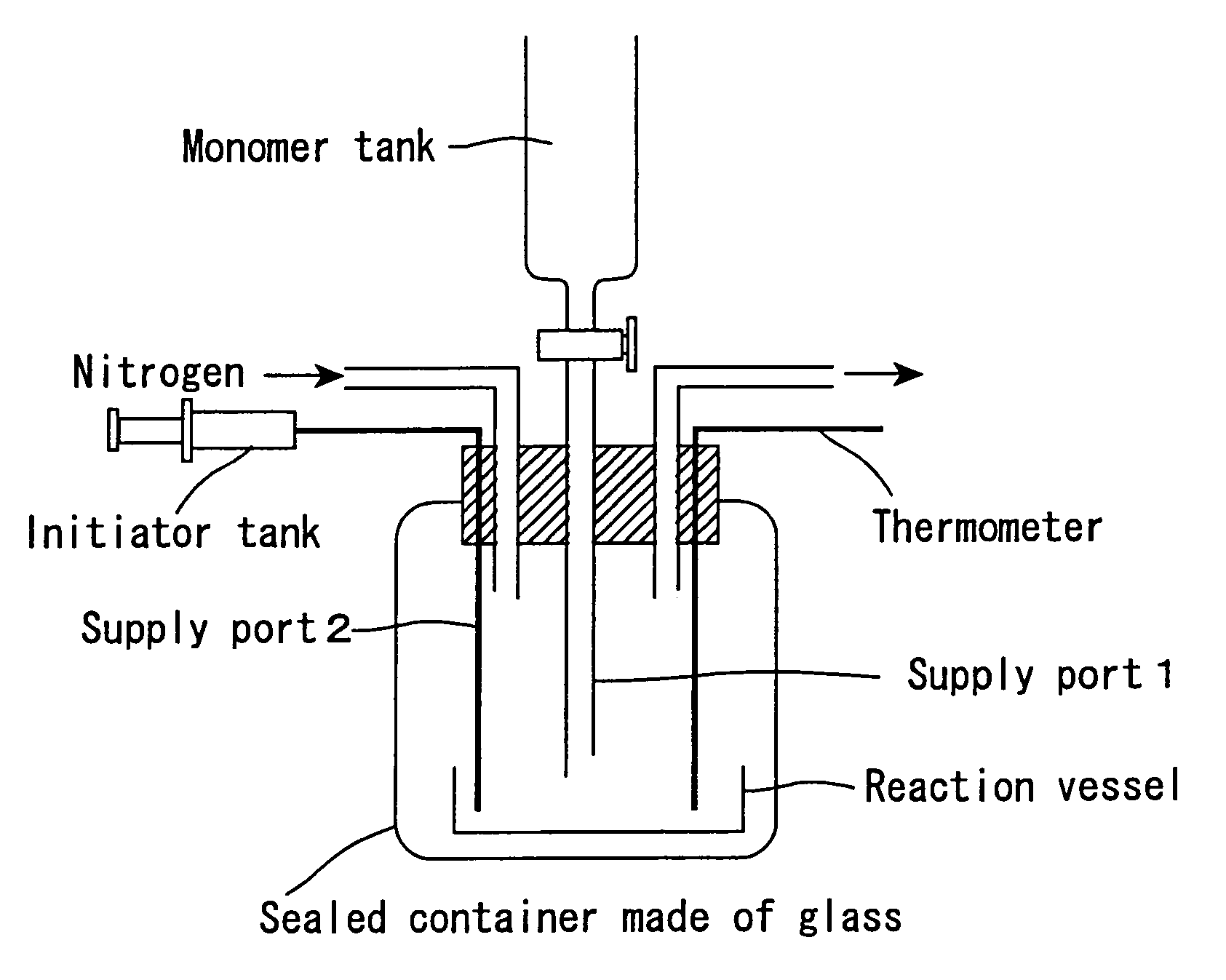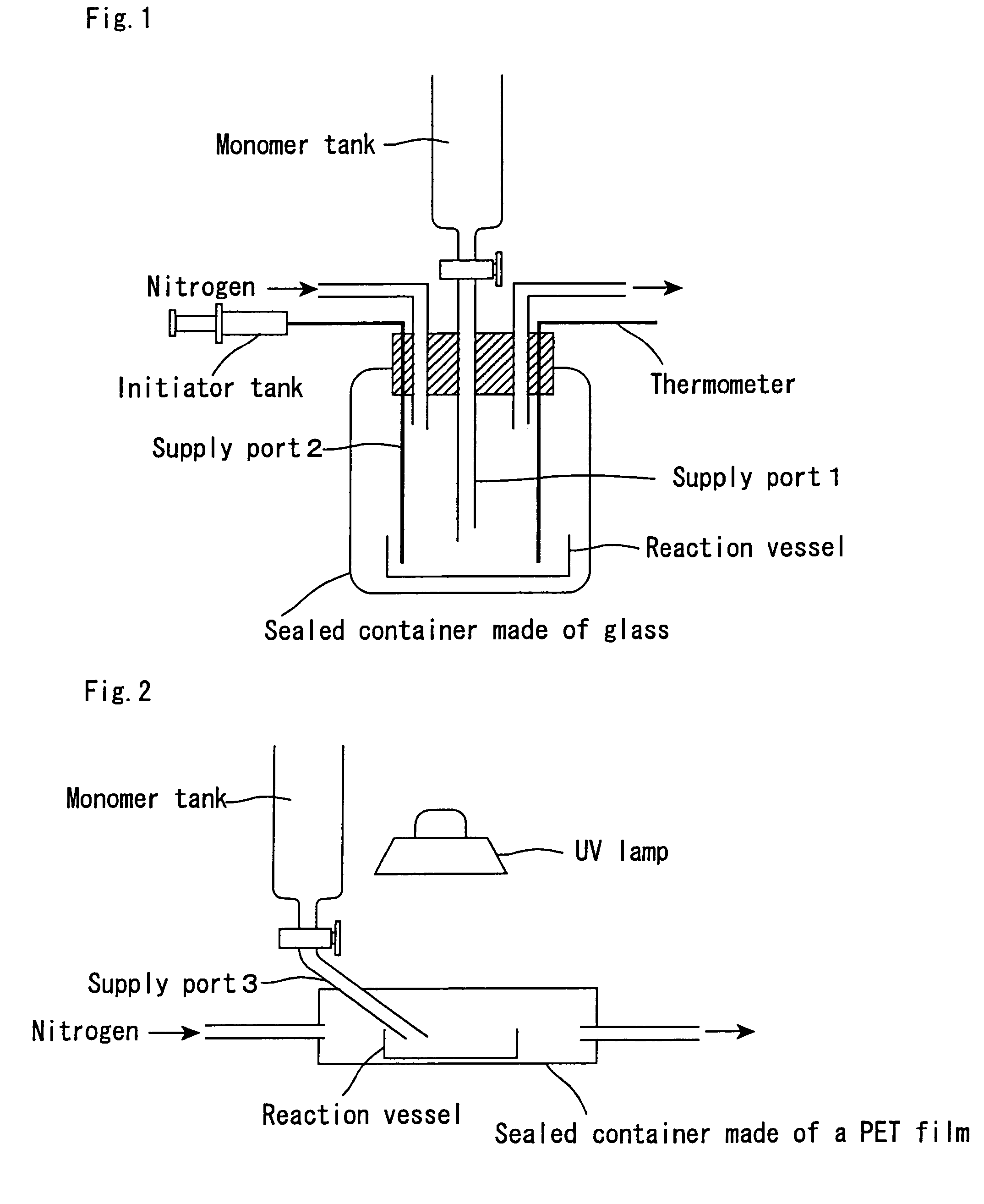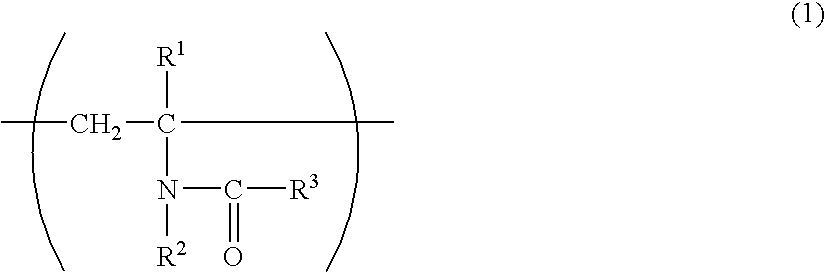N-vinyl amide polymer and production method thereof
a technology of n-vinyl amide and polymer, which is applied in the field of n-vinyl amide polymer and production method thereof, can solve the problems of insufficient suppression of 2-pyrrolidone and ash components, inability to avoid coloration or coloration over time, and insufficient removal of 2-pyrrolidone, a hydrolysis product, etc., to achieve suppressed coloration, reduced contents, and higher k-value
- Summary
- Abstract
- Description
- Claims
- Application Information
AI Technical Summary
Benefits of technology
Problems solved by technology
Method used
Image
Examples
example 1
[0165]This example was carried out using a polymerization reaction apparatus shown in FIG. 1. An aqueous monomer solution containing 60 parts of N-vinylpyrrolidone and 40 parts of ion-exchanged water was prepared and nitrogen was bubbled in the solution to sufficiently remove dissolved oxygen. The aqueous monomer solution was fed through a supply port 1 to a reaction vessel whose inside was previously replaced with nitrogen and heated to surface temperature of 100° C. and successively an initiator solution obtained by dissolving 0.06 parts of azo initiator V-59 (trade name; manufactured by Wako Pure Chemical Industries, Ltd.; 2,2′-azobis(2-methylbutyronitrile)) in 1 part of isopropyl alcohol (IPA) was fed through a supply port 2. The solution depth of the reaction solution in the reaction vessel was 10 mm. Under nitrogen flow, polymerization was carried out and the temperature of the reaction solution reached 100° C. in approximately 5 minutes. Thereafter, the temperature of 100° C....
example 2
[0167]Reaction was carried out in completely same manner as in Example 1, except that the amount of the azo initiator was changed to be 0.12 parts. The temperature of the reaction solution reached 100° C. in approximately 5 minutes. Thereafter, the temperature of 100° C. or higher was maintained for 12 minutes to obtain colorless, transparent, and slightly soft solid cake. It was found by analysis that the obtained cake had a K-value of 95.3, contained 2400 ppm of N-vinylpyrrolidone to the resin component and 0.1 ppm of 2-pyrrolidone. The APHA of a 10% aqueous solution was 5 and the content of ashes was 200 ppm. Table 1 shows these results.
example 3
[0168]Reaction was carried out in completely same manner as in Example 1, except that the total amount of the aqueous monomer solution was adjusted and the liquid depth of the reaction solution was changed to be 15 mm. The temperature of the reaction solution reached 100° C. in approximately 5 minutes. Thereafter, the temperature of 100° C. or higher was maintained for 17 minutes to obtain colorless, transparent, and slightly soft solid cake. It was found by analyses that the obtained cake had a K-value of 100.0, contained 5700 ppm of N-vinylpyrrolidone to the resin component and 0.2 ppm of 2-pyrrolidone. The APHA of a 10% aqueous solution was 5 and the content of ashes was 200 ppm. Table 1 shows these results.
PUM
| Property | Measurement | Unit |
|---|---|---|
| temperature | aaaaa | aaaaa |
| depth | aaaaa | aaaaa |
| thickness | aaaaa | aaaaa |
Abstract
Description
Claims
Application Information
 Login to View More
Login to View More - R&D
- Intellectual Property
- Life Sciences
- Materials
- Tech Scout
- Unparalleled Data Quality
- Higher Quality Content
- 60% Fewer Hallucinations
Browse by: Latest US Patents, China's latest patents, Technical Efficacy Thesaurus, Application Domain, Technology Topic, Popular Technical Reports.
© 2025 PatSnap. All rights reserved.Legal|Privacy policy|Modern Slavery Act Transparency Statement|Sitemap|About US| Contact US: help@patsnap.com



